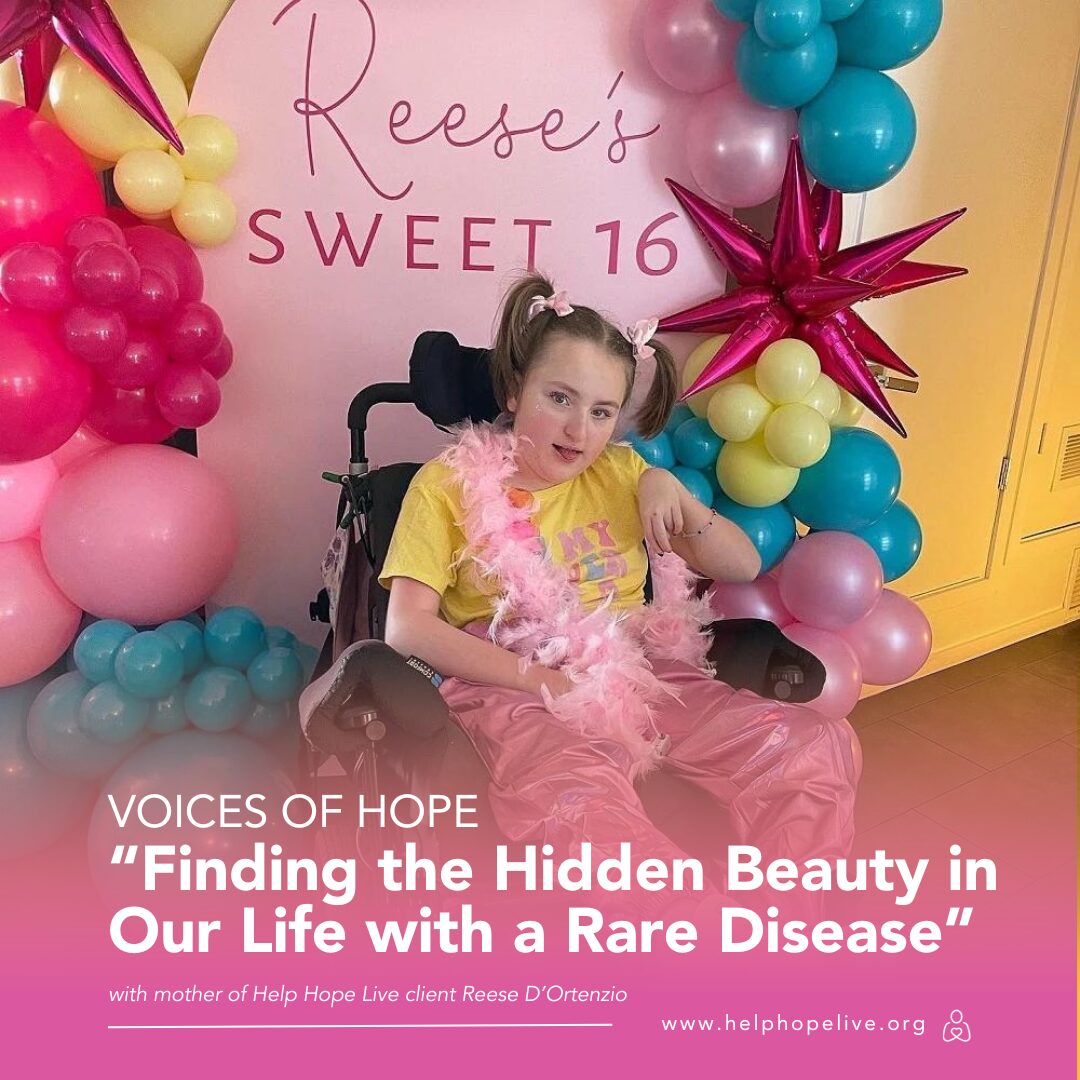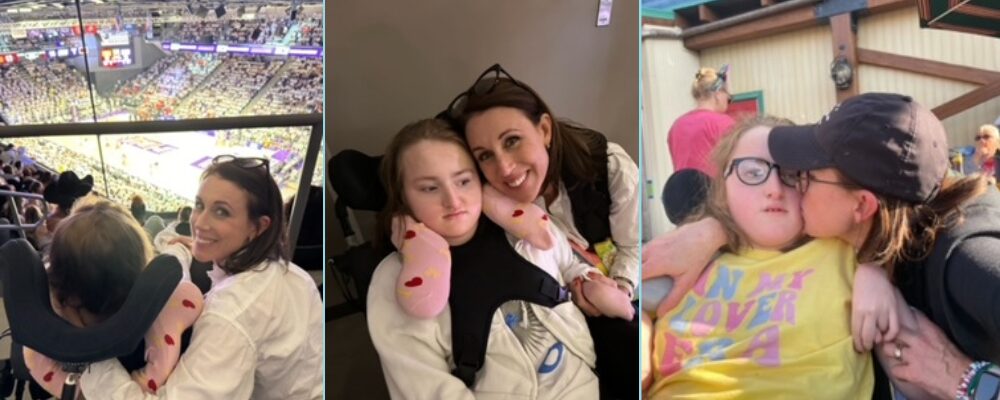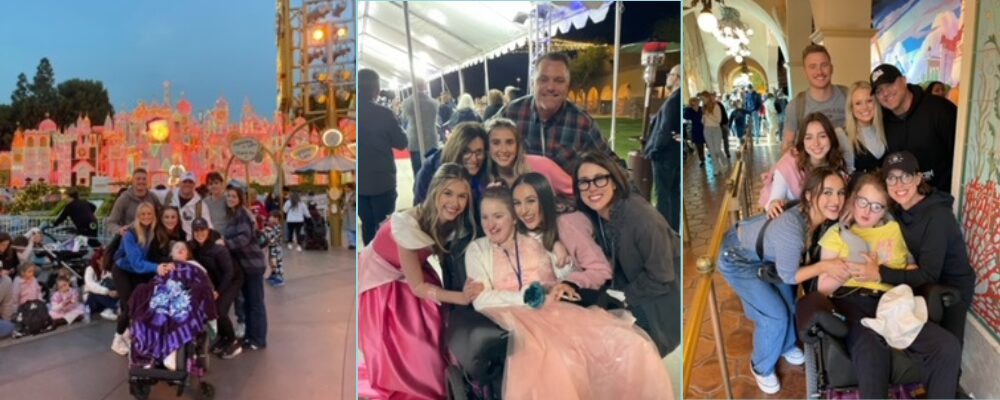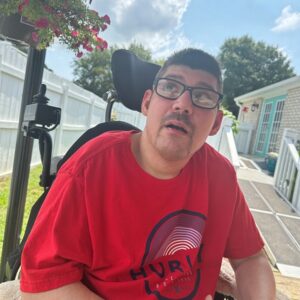16-year-old Reese D’Ortenzio is living with Aicardi syndrome.
We asked Reese’s mother, Kerry, to tell us about how living with a rare disease influences her family’s daily life—from navigating medical expenses through fundraising to learning that Reese is “a beautiful treasure—one that could only be found by those who take the time to sift and look for it.”

How much did you know about disabilities and rare illnesses prior to Reese’s diagnosis?
I actually got a degree in Special Education when I was in my 20s, so I had some experience with the disability community.
I think I have been drawn to people with disabilities for most of my life, because I grew up next door to a boy living with Down syndrome. He brought so much joy to our lives.
I think he was my first introduction to the (maybe lesser-known) happy world of disabilities.

On the other hand, I didn’t know much about rare diseases until I HAD to know.
I knew I had to become an expert on the syndrome and everything we could do to make her life the best it could be.
What was it like to be pregnant with Reese knowing she would be born with a disability?
There is a very specific moment that represents a turning point for me in how I experienced the time before Reese was born.
I was very pregnant with Reese, and imaging had indicated that cysts were growing on her brain. We were sitting in the waiting room of the neurosurgeon’s office at a children’s hospital. We knew she would need surgery soon after birth, so we were meeting with a surgeon to learn more.
We did not know what to expect with Reese’s life. Our minds were spiraling, thinking about all the tough things that would likely lie ahead for us.
In the waiting room, there was a dad sitting across the room from us, holding his son, who had visible disabilities.
The two of them were wrapped up in loving each other—smiling, cuddling, and laughing.
When I saw them, I knew I would love my child, no matter what, and that she would love me, too.

What were you told to expect for how Aicardi syndrome would impact Reese’s health and mobility over time?
Reese was diagnosed with Aicardi syndrome within a few weeks of her birth. Her eye doctor was the one who saw the telltale sign on her retinas. He wrote down “Aicardi syndrome” in pencil on a 3×5 card and told me I’d want to Google it.
I went home and did just that.
The first search result was titled, “In Loving Memory.” That was a bad day.
The first description of the syndrome we found said she would have several mental and physical disabilities, a lifetime of uncontrolled seizures, and a life expectancy of seven to 14 years. Our neurologist told us she would never progress beyond the development of a six-month-old.
As we did more research into the lives of people living with the syndrome, we discovered that there is a very wide range of abilities and mobility levels within the diagnosis.
That gave us hope that more was possible for Reese than what we had originally been told.

How has Reese challenged that initial prognosis over time?
Although she is on the more severe side of the spectrum for the diagnosis in terms of mobility, she definitely has an understanding and emotional capacity beyond what we were told to expect.
Although she is non-speaking with delayed reactions, we can assume Reese understands everything we say.

Reese is joyful, peaceful, happy, and accepting. She expresses her emotions, likes and dislikes, and preferences, and she is very good at engaging emotionally with people. She expresses joy and interacts with sounds and laughter.
How does Reese’s life look different from other teens her age?
Reese’s life is very different from other 16-year-olds because she requires total care, which means we do pretty much everything for her.
She does not walk and she is non-speaking, so she is with us or with one of her nurses at all times. She is fed via G-tube and she still has seizures weekly, so we keep very close tabs on her.
Because Reese is medically fragile, she is homebound for school, and her teachers and therapists come to our house for services.
Her social circle is limited to her sisters, cousins, aunts and uncles, grandparents, nurses, and therapists. Reese has three sisters: Faith, who is 25; Mia, who is 23; and Olivia, who is 20.
She greatly enjoys her time with each and every one of her family members, teachers, and therapists!

What are some of the qualities that make Reese similar to other teens her age?
Reese loves Taylor Swift, loud music, and watching movies with her family.
She likes cute boys, and she lights up when you tell her how beautiful she is.
Reese loves to get dressed up for special occasions. She loves going to Disneyland and basketball games with her family, especially when the music is loud and the lights are bright!

What is Reese’s schedule like for appointments and therapy?
Reese gets physical therapy every week and sees speech, vision, and occupational therapists through the school district several times per month. We have doctor appointments at least once per month. Reese also gets several treatments daily at home for her respiratory health.
Because we can do so many treatments at home, Reese has not had a hospital stay since 2016.
How has Reese’s life and personality defied expectations—from the world or even from yourself?
When Reese was diagnosed, I felt like the world was ending.
I was told we would lose her at a young age and that the life she would live until then would be extremely difficult. I felt hopeless and just sad. I didn’t know how I would ever smile or laugh again with this horrible reality hanging over us.
I remember reading that the root of the word “crisis” means “to sift.” I pictured myself on the beach with a colander full of sand, the sand pouring through the tiny holes to reveal the sea glass that remained.
The sea glass was a beautiful treasure—one that could only be found by those who took the time to sift and look for it.
Reese is that sea glass. She is the beautiful gem hidden in the sand.
At one point, I remember my husband saying, “This is going to be an adventure. We can either look for what is great about it, or we can feel sorry for ourselves.”
We decided to look for the beauty, and it has made all the difference.
Some of that beauty is in the unique peace that Reese brings to our home. It’s the light in her eyes that says, “I am so happy to be with you.” It reminds me of the way God looks at us, as described in Psalm 16.
It’s the incredible care from the people around us in words and deeds and generosity.
It’s the impact of the kindness of a stranger who sees and values Reese. It makes me recognize the impact we can all have on one another.
It’s the closeness that develops in a family when we all care deeply for one of us who needs extra attention.
It’s the extraordinary care and closeness of God that we have experienced as we have relied on Him, each and every day.
What I thought would be only sad turned out to be a beautiful, unexpected gift in so many ways.

What are some of the ways Reese shows love to you and the other loved ones in her life?
Reese is patient, kind, and fully accepting of who you are—just as you are. Reese’s eyes and smile are full of light and love.
Reese shows love by lighting up when she sees your face. It will change your mood instantly.

She vocalizes her joy at being in your presence.
She says “I love you” in her own ways. Sometimes, it’s laughing uncontrollably. She gives hugs and loves to cuddle. She uses switch technology to say, “I love you.” Reese doesn’t fake-smile, so when she smiles at you, you know she really likes you!
Her eye-gaze device is on the way, and we can’t wait to hear what else she has to say.
At what stage in Reese’s life did you encounter the burden of medical expenses and related costs?
The first big expense was a wheelchair accessible vehicle, which we got in 2014.
Insurance did not pay for any of the cost of the accessible vehicle.
Our insurance paid for a bathroom retrofitting for accessibility in 2013. However, as Reese has gotten older, she has developed different needs for showering. We had to add onto our house to create an accessible bathroom for her in 2020.
None of those home modification costs were covered by insurance. It was completely out of pocket.
We still need to add some ramps to our home and widen our doorways. Fundraising with Help Hope Live will help us to complete that project.
Another big expense is an accessible vehicle that will provide a safer and more dynamic option for Reese so she can continue to live life to the fullest. Our current van is not large enough to allow her wheelchair to turn to face forward using the side entry.
While we need the transportation for medical appointments, there is also a lot of life to be lived in between.
We want her to be able to live a life outside of our home and easily get out the door and in and out of the vehicle. Reese’s sister and brother-in-law live out-of-state, and we want her to be able to comfortably travel to see them.
New vehicles that can accommodate her chair are $90,000 to $100,000 without help from insurance.
That’s why fundraising is such a key part of this journey.
Meeting our fundraising goal will feel like freedom.
It will mean we can take Reese with us anywhere, without any barriers. We can comfortably travel and expand her borders. She has a lot of life to live!
Why did you choose to fundraise with Help Hope Live?
Working with Help Hope Live has given me hope that we can do this, and that we are not the only family facing a similar situation.
I love that donors can make tax-deductible gifts by giving to Help Hope Live in Reese’s honor. I also love that the campaign can stay active for Reese’s whole life, and that the funds raised can be used for any medical and related expenses.
The professionalism and responsiveness of our Client Services Coordinator, Jen, have made the process so easy.
How has community-based fundraising impacted your family so far?
It gives us strength to know that people care about Reese and are willing to help fund the things she needs.
We are so grateful for every person who chooses to donate. It is incredibly encouraging. I hope they know that it blesses us deeply, no matter the amount.
It makes us feel that we are cared for and that we are not alone.

What is one thing you wish more people understood about Reese and individuals like her?
Our world typically evaluates people based on what they produce.
What are you going to do with your life? How are you going to produce something so that you can earn something—and earn value?
Whether it is expressed explicitly or not, this is the hum beneath the surface of our culture.
Reese has taught me that every person’s life has a unique purpose and value, and that it’s our job to look for it.

Reese will not earn money or produce a good or a service in her lifetime. She won’t get married or raise children. But she gives and receives love more than anyone else I know.
She has no guile, no grudges, no pretense—she has no entitlement, no demands, no self-importance.
Reese’s ability to show that she is happy to see you is a tremendous gift that is of great value to all who know her.
I just wish the world could see and acknowledge that value—and not just Reese’s, but the value of every person living with a disability.
Please make room for people with disabilities. Show them that you believe they deserve to be in the room.
Not because you are a good person or it’s the right thing to do, but because you recognize their value and their love.
They are humans with significance and inherent value. Let them love you. You probably need it!
What does rare disease awareness mean to you?
Aicardi syndrome can be very difficult—that goes without saying. Just because we adore Reese doesn’t negate the fact that her diagnosis has brought with it many challenges.
While I have a hard time celebrating the concept of rare diseases or her diagnosis, what I do celebrate is the lives it represents.
I celebrate the resiliency of our children, who suffer medical traumas, really hard days, and ongoing treatments.
I celebrate people who endure hardship and find the joy in the midst of it all.
I celebrate the strength and love of the parents who never give up, who persist in treatments, who cry in the shower and then start again—who keep going. All because of love.
In bringing awareness to rare diseases, we can foster a greater sense of compassion and awareness surrounding the reality of life with a rare disease.
Those who are willing to listen will better understand the need. If they have the ability to lighten the load, financially or emotionally, they will take the opportunity to do so—and they will change the lives of people affected by rare diseases as a result.
Like the dad in the waiting room loving his child, each of us can profoundly impact someone else around us, even just by showing our love.
It may be through how we love our own child, or it may be through how we help someone in need through an organization like Help Hope Live.
Every single act done in love impacts someone around you.
That is one thing I know for sure.

Find Reese’s Campaign Page at helphopelive.org.
Written by Emily Progin










